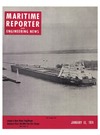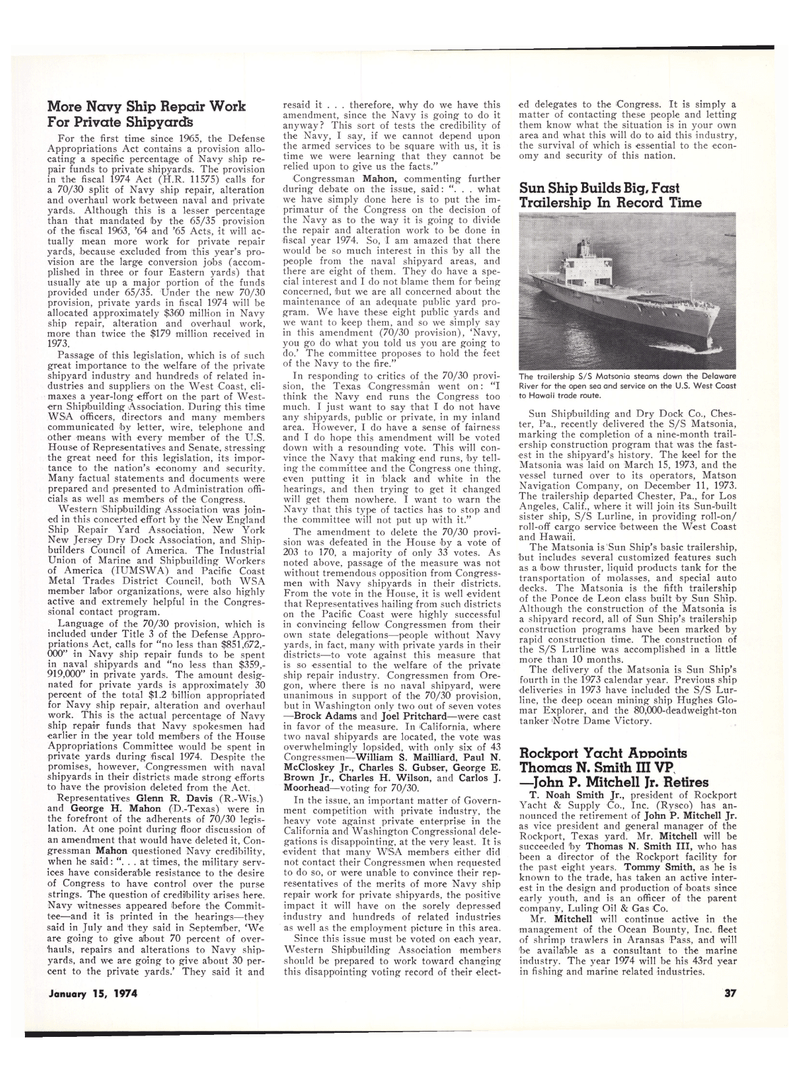
Page 35: of Maritime Reporter Magazine (January 15, 1974)
Read this page in Pdf, Flash or Html5 edition of January 15, 1974 Maritime Reporter Magazine
More Navy Ship Repair Work
For Private Shipyards
For the first time since 1965, the Defense
Appropriations Act contains a provision allo- cating a specific percentage of Navy ship re- pair funds to private shipyards. The provision in the fiscal 1974 Act (H.R. 11575) calls for a 70/30 split of Navy ship repair, alteration and overhaul work between naval and private yards. Although this is a lesser percentage than that mandated Iby the 65/35 provision of the fiscal 1963, '64 and '65 Acts, it will ac- tually mean more work for private repair yards, because excluded from tbis year's pro- vision are the large conversion jobs (accom- plished in three or four Eastern yards) that usually ate up a major portion of the funds provided under 65/35. Under the new 70/30 provision, private yards in fiscal 1974 will be allocated approximately $360 million in Navy ship repair, alteration and overhaul work, more than twice the $179 million received in 1973.
Passage of this legislation, which is of such great importance to the welfare of the private shipyard industry and hundreds of related in- dustries and suppliers on the West Coast, cli- maxes a year-long effort on the part of West- ern Shipbuilding Association. During this time
WSA officers, directors and many members communicated by letter, wire, telephone and other means with every member of the U.S.
House of Representatives and Senate, stressing the great need for this legislation, its impor- tance to the nation's economy and security.
Many factual statements and documents were prepared and presented to Administration offi- cials as well as members of the Congress.
Western Shipbuilding Association was join- ed in this concerted effort by the New England
Ship Repair Yard Association. New York
New Jersey Dry Dock Association, and Ship- builders Council of America. The Industrial
Union of Marine and Shipbuilding Workers of America (IUMSWA) and Pacific Coast
Metal Trades District Council, both WSA member labor organizations, were also highly active and extremely helpful in the Congres- sional contact program.
Language of the 70/30 provision, which is included under Title 3 of the Defense Appro- priations Act, calls for "no less than $851,672,- 000" in Navy ship repair funds to be spent in naval shipyards and "no less than $359,- 919,000" in private yards. The amount desig- nated for private yards is approximately 30 percent of the total $1.2 billion appropriated for Navy ship repair, alteration and overhaul work. This is the actual percentage of Navy ship repair funds that Navy spokesmen had earlier in the year told members of the House
Appropriations Committee would be spent in private yards during fiscal 1974. Despite the promises, however, Congressmen with naval shipyards in their districts made strong efforts to have the provision deleted from the Act.
Representatives Glenn R. Davis (R.-Wis.) and George H. Mahon (D.-Texas) were in the forefront of the adherents of 70/30 legis- lation. At one point during floor discussion of an amendment that would have deleted it, Con- gressman Mahon questioned Navy credibility, when he said: ". . . at times, the military serv- ices have considerable resistance to the desire of Congress to have control over the purse strings. The question of credibility arises here.
Navy witnesses appeared before the Commit- tee—and it is printed in the hearings—they said in July and they said in September, 'We are going to give aJbout 70 percent of over- hauls, repairs and alterations to Navy ship- yards, and we are going to give about 30 per- cent to the private yards.' They said it and resaid it . . . therefore, why do we have this amendment, since the Navy is going to do it anyway? This sort of tests the credibility of the Navy, I say, if we cannot depend upon the armed services to be square with us, it is time we were learning that they cannot be relied upon to give us the facts."
Congressman Mahon, commenting further during debate on the issue, said: ". . . what we have simply done here is to put the im- primatur of the Congress on the decision of the Navy as to the way it is going to divide the repair and alteration work to be done in fiscal year 1974. So, I am amazed that there would be so much interest in this by all the people from the naval shipyard areas, and there are eight of them. They do have a spe- cial interest and I do not blame them for being concerned, but we are all concerned about the maintenance of an adequate public yard pro- gram. We have these eight public yards and we want to keep them, and so we simply say in this amendment (70/30 provision), 'Navy, you go do what you told us you are going to do.' The committee proposes to hold the feet of the Navy to the fire."
In responding to critics of the 70/30 provi- sion, the Texas Congressman went on: "I think the Navy end runs the Congress too much. I just want to say that I do not have any shipyards, public or private, in my inland area. However, I do have a sense of fairness and I do hope this amendment will be voted down with a resounding vote. This will con- vince the Navy that making end runs, by tell- ing the committee and the Congress one thing, even putting it in black and white in the hearings, and then trying to get it changed will get them nowhere. I want to warn the
Navy that this type of tactics has to stop and the committee will not put up with it."
The amendment to delete the 70/30 provi- sion was defeated in the House by a vote of 203 to 170, a majority of only 33 votes. As noted above, passage of the measure was not without tremendous opposition from Congress- men with Navy shipyards in their districts.
From the vote in the House, it is well evident that Representatives hailing from such districts on the Pacific Coast were highly successful in convincing fellow Congressmen from their own state delegations—people without Navy yards, in fact, many with private yards in their districts—to vote against this measure that is so essential to the welfare of the private ship repair industry. Congressmen from Ore- gon, where there is no naval shipyard, were unanimous in support of the 70/30 provision, but in Washington only two out of seven votes —Brock Adams and Joel Pritchard—were cast in favor of the measure. In California, where two naval shipyards are located, the vote was overwhelmingly lopsided, with only six of 43
Congressmen—William S. Mailliard, Paul N.
McCloskey Jr., Charles S. Gubser, George E.
Brown Jr., Charles H. Wilson, and Carlos J.
Moorhead—voting for 70/30.
In the issue, an important matter of Govern- ment competition with private industry, the heavy vote against private enterprise in the
California and Washington Congressional dele- gations is disappointing-, at the very least. It is evident that many WSA members either did not contact their Congressmen when requested to do so, or were unable to convince their rep- resentatives of the merits of more Navy ship repair work for private shipyards, the positive impact it will have on the sorely depressed industry and hundreds of related industries as well as the employment picture in this area.
Since this issue must be voted on each year,
Western Shipbuilding Association members should be prepared to work toward changing this disappointing voting record of their elect- ed delegates to the Congress. It is simply a matter of contacting these people and letting them know what the situation is in your own area and what this will do to aid this industry, the survival of which is essential to the econ- omy and security of this nation.
Sun Ship Builds Big, Fast
Trailership In Record Time
The trailership S/S Matsonia steams down the Delaware
River for the open sea and service on the U.S. West Coast to Hawaii trade route.
Sun Shipbuilding and Dry Dock Co., Ches- ter, Pa., recently delivered the S/S Matsonia, marking the completion of a nine-month trail- ership construction program that was the fast- est in the shipyard's history. The keel for the
Matsonia was laid on March 15, 1973, and the vessel turned over to its operators, Matson
Navigation Company, on December 11, 1973.
The trailership departed Chester, Pa., for Los
Angeles, Calif., where it will join its Sun-built sister ship, S/S Lurline, in providing roll-on/ roll-off cargo service between the West Coast and Hawaii.
The Matsonia is'Sun Ship's basic trailership, but includes several customized features such as a bow thruster, liquid products tank for the transportation of molasses, and special auto decks. The Matsonia is the fifth trailership of the Ponce de Leon class built by Sun Ship.
Although the construction of the Matsonia is a shipyard record, all of Sun Ship's trailership construction programs have been marked by rapid construction time. The construction of the S/S Lurline was accomplished in a little more than 10 months.
The delivery of the Matsonia is Sun Ship's fourth in the 1973 calendar year. Previous ship deliveries in 1973 have included the S/S Lur- line, the deep ocean mining ship Hughes Glo- mar Explorer, and the 80,000-deadweight-ton tanker Notre Dame Victory.
Rockport Yacht Appoints
Thomas N. Smith III VP —lohn P. Mitchell Jr. Retires
T. Noah Smith Jr., president of Rockport
Yacht & Supply Co., Inc. (Rysco) has an- nounced the retirement of John P. Mitchell Jr. as vice president and general manager of the
Rockport, Texas yard. Mr. Mitchell will be succeeded by Thomas N. Smith III, who has been a director of the Rockport facility for the past eight years. Tommy Smith, as he is known to the trade, has taken an active inter- est in the design and production of boats since early youth, and is an officer of the parent company, Luling Oil & Gas Co.
Mr. Mitchell will continue active in the management of the Ocean Bounty, Inc. fleet of shrimp trawlers in Aransas Pass, and will be available as a consultant to the marine industry. The year 1974 will be his 43rd year in fishing and marine related industries.
January 15, 1974 37

 34
34

 36
36
